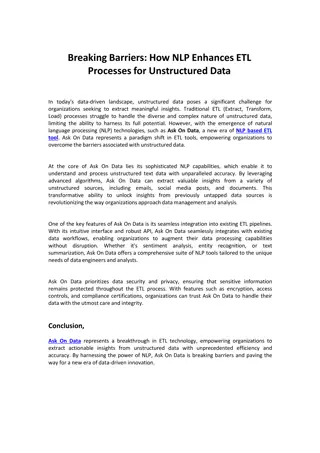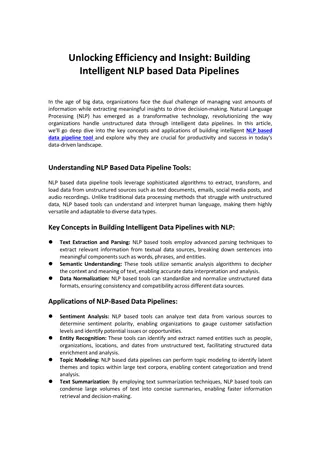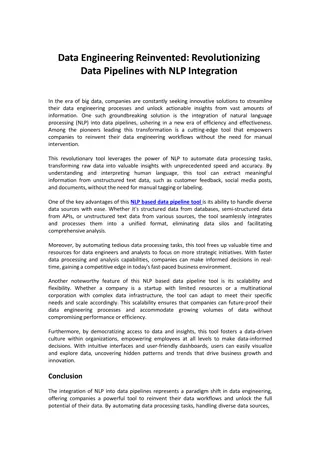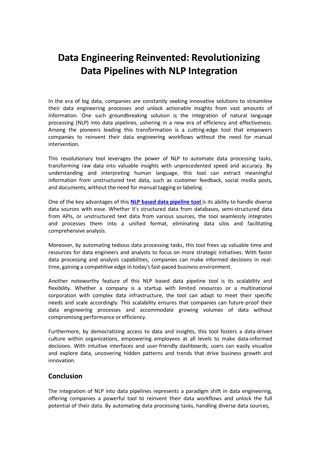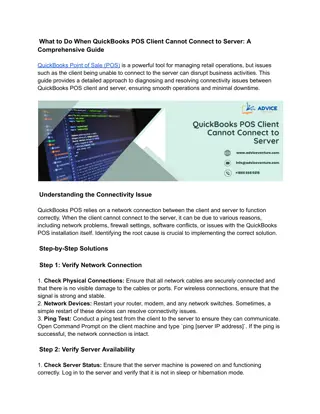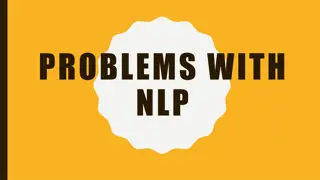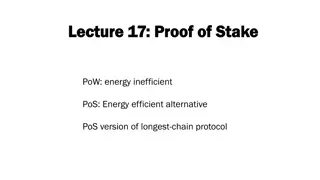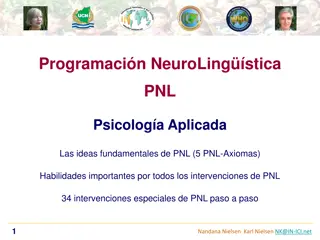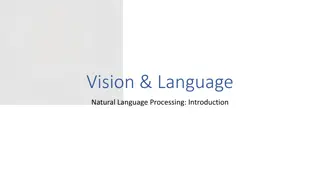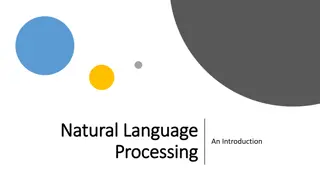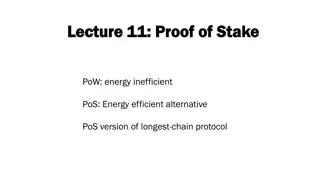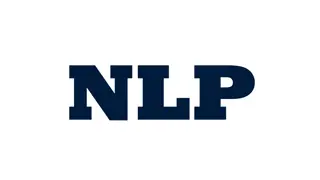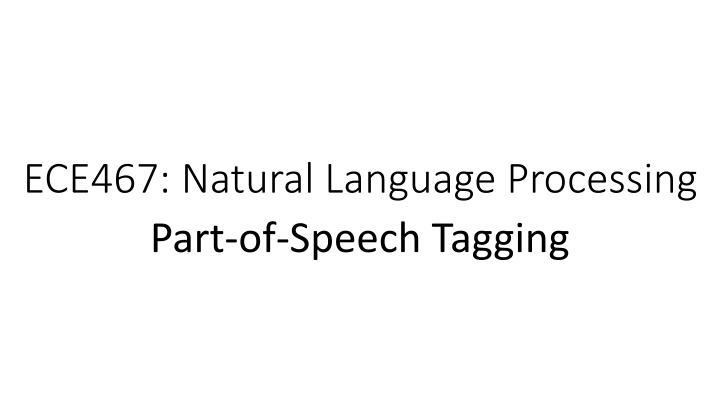
Parts of Speech and Tagging in Natural Language Processing
Explore the history and concepts of parts of speech in natural language processing, including open and closed classes, with a focus on defining various categories. Dive into the syntactic and morphological functions that define word classes and their roles in text analysis.
Download Presentation

Please find below an Image/Link to download the presentation.
The content on the website is provided AS IS for your information and personal use only. It may not be sold, licensed, or shared on other websites without obtaining consent from the author. If you encounter any issues during the download, it is possible that the publisher has removed the file from their server.
You are allowed to download the files provided on this website for personal or commercial use, subject to the condition that they are used lawfully. All files are the property of their respective owners.
The content on the website is provided AS IS for your information and personal use only. It may not be sold, licensed, or shared on other websites without obtaining consent from the author.
E N D
Presentation Transcript
ECE467: Natural Language Processing Part-of-Speech Tagging
Parts of Speech This topic is largely based on Chapter 8 of the textbook, titled "Sequence Labeling for Parts of Speech and Named Entities" Some information is left from the previous edition of the textbook Parts of speech (POS) are categories for words that indicate their syntactic functions In other sources, parts of speech are sometimes called word classes, lexical tags, or syntactic categories The chapter starts by mentioning a few facts related to the history of parts of speech Dionysius Thrax of Alexandra (c. 100 B.C.) is generally credited for creating a work summarizing the linguistic knowledge of his day Our textbook says it is possible that it was really someone else Included was the description of eight parts-of-speech: noun, verb, pronoun, preposition, adverb, conjunction, participle, and article Earlier lists include those from Aristotle and the Stoics, but Thrax's became the basis for POS descriptions for the next 2000 years
Open and Closed Classes of POS POS can be divided into two broad categories: open classes and closed classes According to the textbook, "Four major open classes occur in the languages of the world": nouns (including proper nouns), verbs, adjectives, and adverbs Not every language has all four open classes (of course, English does) New nouns and verbs are continually added to languages (sometimes borrowed from other languages) The current draft of the new edition of the textbook also considers interjections to be a "smaller open class" Many modern tagsets (a concept that will be explained soon) include separate tags for things such as plural nouns, various tenses of verbs, etc. We will soon see that the Universal Dependencies tagset includes interjections as an open class, and it also includes proper nouns as an open class category distinct from nouns Closed classes (e.g., prepositions) have relatively fixed membership Closed classes generally include function words (e.g., "of", "it", "and", "you", etc.), which tend to be very short and occur frequently
Defining Parts of Speech Traditionally, linguist's definitions of POS are based on syntactic and morphological function That is, words in a class function similarly with respect to what can occur nearby and/or what affixes they can take Word classes have tendencies toward semantic coherence, but not always For example, nouns often describe people, places, or things, and adjectives often describe properties, but there are other possibilities In general, linguists do not agree about what all the POS categories should be, or about how each part of speech should be defined We'll discuss properties of common POS a bit later in the topic
POS Tagsets Most modern lists of parts of speech, called tagsets, for English include many more word classes than we have been discussing The Brown corpus tagset includes 87 tags (some sources claim different numbers) The Penn Treebank tagset includes 45 tags, according to our textbook Only 36 of the tags represent what we typically think of as POS The rest of the tags are for various types of punctuation, and I've seen different version of the tagset contain as few as 8 or as many as 12, with 9 being a common variation The C7 tagset includes 146 tags The Universal Dependencies (UD) tagset, which is newer, includes only 17 tags The goal of the creators of the UD framework was to create resources that can be used across multiple languages Features can be added to make find-grained distinctions, but we will not discuss how this works The next slide shows the 17 tags from the Universal Dependencies tagset Later, we'll look at POS tags from the Penn Treebank tagset
Uses of POS Knowing the POS of a word gives you information about its neighbors Examples: possessive pronouns (e.g., "my", "her", "its") are likely to be followed by nouns, while personal pronouns (e.g., "I", "you", "he") are likely to be followed by verbs POS can tell us about how a word is pronounced (e.g., "content" as a noun vs. an adjective) POS can also be useful for applications such as parsing, named entity recognition, and coreference resolution Corpora that have been marked with parts of speech are useful for linguistic research Part-of-speech tagging (a.k.a. POS tagging or sometimes just tagging) is the automatic assignment of POS to words POS tagging is often an important first step before several other NLP applications can be applied We will discuss the use of hidden Markov models (HMMs) for POS tagging later in the topic There are also deep learning approaches for POS tagging, which tend to perform a bit better (we'll learn about such methods later in the course)
English Nouns Noun is the name given to the syntactic class in which the words for most people, places, or things occur However, this is not how the class is defined by linguists, and there are exceptions in both directions Nouns include concrete terms (e.g., "cat", "chair"), abstractions (e.g., "algorithm", "beauty"), verb-like terms (e.g., "pacing"), etc. What defines a noun in English are things like: Its ability to occur with determiners (e.g., "a goat", "its bandwidth", "Plato's Republic") Its ability to take possessives (e.g., "IBM's annual revenue") For most (but not all) nouns, its ability to occur in the plural form (e.g., "goats", "abaci")
Types of Nouns Nouns include proper nouns and common nouns Another subclass of nouns called pronouns will be discussed later (along with other closed classes) Proper nouns are names of specific persons or entities In English, they are not usually preceded by articles (e.g., "Regina is upstairs") In written English, they are usually capitalized In many languages, including English, common nouns are further divided into two categories: Count nouns allow grammatical enumeration They can occur in both singular and plural form (e.g., "goat/goats", "relationship/ relationships"), and they can be counted (e.g., "one goat", "two goats") Mass nouns are used for things conceptualized as a homogeneous group (e.g., "snow", "salt", "communism") They are not counted and can appear without articles (e.g., "snow is white")
English Verbs The verb class includes most words referring to actions and processes In English, verbs have several morphological forms (e.g., "eat", "eats", "ate", "eating", "eaten") Recall from our previous topic that irregular verbs can have fewer or more forms than regular forms Nouns in English can be singular or plural, but they generally have fewer morphological forms than verbs A subclass of verbs called auxiliary verbs will be discussed later (along with other closed classes) Many linguists believe that all human languages include nouns and verbs However, some have argued that certain languages (e.g., Riau Indonesian and Tongan) don't even have this distinction
English Adjectives Semantically, the class of adjectives includes many words that describe properties or qualities (e.g., color, age, value, etc.) The textbook claims that some languages do not contain adjectives, but it is not entirely clear if this is correct The textbook states: "In Korean, for example, the words corresponding to English adjectives act as a subclass of verbs" As an example, they say that the English adjective "beautiful" acts in Korean like a verb meaning "to be beautiful" I add: This is not correct; my wife has convinced me that Korean does include adjectives, and other sources have backed her up! (I'll give more details in class) I have not found a definite answer as to whether there are any languages that clearly do not contain adjectives
English Adverbs According to the textbook (previous edition), the class of adverbs "is rather a hodge-podge in both form and meaning" (shortened in the current draft to "adverbs are a hodge-podge") In this example from the book, every italicized word is an adverb: "Actually, I ran home extremely quickly yesterday." Book (earlier draft and previous edition): "What coherence the class has semantically may be solely that each of these words can be viewed as modifying something" I add: I would consider this syntactic coherence, not semantic coherence Types of adverbs include: Directional adverbs or locative adverbs specify the direction or location of some action (e.g., "home", "here", "downhill") Degree adverbs specify the extent of some action, process, or property (e.g., "extremely", "very", "somewhat") Manner adverbs describe the manner of some action or process (e.g., "slowly", "slinkily", "delicately") Temporal adverbs describe the time that some action or event took place (e.g., "yesterday", "Monday"); some tagging schemes tag words like "Monday" as a noun
English Closed Classes The closed classes differ more from language to language than do the open classes Some of the more important closed classes in English include (we will discuss most of these in more detail): Prepositions (e.g., "on", "under", "over", "near", "by", "at", "from", "to", "with") Particles (e.g., "up", "down", "on", "off", "in", "out", "at", "by") Determiners (e.g., "a", "an", "the", "this", "that") Conjunctions (e.g., "and", "but", "or", "as", "if", "when") Pronouns (e.g., "she", "who", "I", "others") Auxiliary verbs (e.g., "can", "may", "should", "are") Numerals (e.g., "one", "two", "three", "first", "second", "third")
English Prepositions and Particles Prepositions occur before noun phrases; semantically, they are relational, often indicating spatial or temporal relations They can be literal (e.g., "on it", "before then", "by the house") or metaphorical ("on time", "with gusto", "beside herself") Sometimes they indicate other types of relations (e.g., "Hamlet was written by Shakespeare") A particle is a word that often resembles a preposition or an adverb and is used in combination with a verb They often have meanings that are not the same as the prepositions or adverbs they resemble; e.g., " she had turned the paper over." When a verb and particle behave as a single unit, the combination is called a phrasal verb A phrasal verb generally has a meaning separate and not predictable from those of the verb and particle; e.g., "turn down", "rule out", "find out", "go on" The previous edition of the textbook pointed out that it is very hard to distinguish particles from prepositions, and some tagsets do not distinguish them
English Determiners A closed class that occurs with nouns, often marking the beginning of a noun phrase, is determiners I add: We'll see in the second unit of the course that some linguists distinguish between determiner phrases and noun phrases One subtype of determiners is the articles; English has three ("a", "an", and "the") The articles "a" and "an" mark a noun phrase as indefinite, while "the" marks it as definite Articles are frequent in English; in fact, "the" is the most common word in most corpora of written English (often by far) I add: It is less clear what is the most common word in spoken English I've seen sources claim it is "the", "OK", "a", "I", etc. (but I haven't seen anything convincing) Other determiners include "this" and "that" (e.g., "this chapter", "that page") Some sources consider a word ending in a possessive 's, used before a noun, to be a determiner (e.g., "Plato's Republic"); earlier editions and drafts of our textbook took this view in some places
English Conjunctions Conjunctions join two phrases, clauses, or sentences Coordinating conjunctions (e.g., "and", "or", "but") join two elements of equal status Subordinating conjunctions are used when one element has an embedded status; e.g., "I thought that you might like some milk." Such subordinating conjunctions that link a verb to its argument are also called complementizers I add: There are many other subordinating conjunctions (e.g., "when", "because", "although", etc.)
English Pronouns Pronouns are a subclass of nouns that often act as a kind of shorthand for referring to some noun phrase, entity, or event Types of pronouns include: Personal pronouns refer to persons or entities (e.g., "you", "she", "I", "it", "me") Possessive pronouns are personal pronouns that indicate actual possession or an abstract relationship (e.g., "my", "your", "his", "her", "its", "our", "their") I add: Some sources consider possessive pronouns to be possessive determiners when they are used before nouns Wh-pronouns (e.g., "what", "who", "whom") are used in certain question forms, or they can act as complementizers (e.g., "Frida, who married Diego ")
English Auxiliary Verbs A close-class subtype of verbs is auxiliary verbs, a.k.a. auxiliaries Auxiliaries in English include: The copula verb (a.k.a. linking verb) "be", which connects a subject with certain kinds of predicate nominals and adjectives (e.g., "he is a duck") Forms of "be" can also be used as part of the passive (e.g., "we were robbed") or progressive (e.g., "we are leaving") constructions The verb "have", when it is used to mark the perfect tenses (e.g., "I have gone", "I had gone") The modal verbs indicate what is called mood, i.e., if an action is necessary, desired, etc. (e.g., "can", "may", "must", "have" as in "I have to go")
Other Possible English Classes The previous edition of the textbook indicated some other English classes for words of "more or less unique function", including: Interjections (e.g., "oh", "hey", "alas", "uh", "um"); as was previously mentioned, some sources including the current draft of the textbook count this as an open class Negatives (e.g., "no", "not") Politeness markers (e.g., "please", "thank you") Greetings (e.g., "hello", "goodbye") The existential there (e.g., "There are two books on the table.") The book notes that some of these classes may be lumped together with interjections or, in some cases, adverbs In general, sources listing English parts of speech, including tagsets, differ significantly as to which POS are included, and on their definitions
The Brown Corpus Tagset Recall from our previous topic (N-grams) that the Brown Corpus consists of 1 million words taken from 500 texts of various genres The Brown Corpus tagset consists of 87 tags The corpus was first tagged by TAGGIT, an early rule-based tagger According to our textbook, this tagger accurately tagged approximately 77% of words (that is very low by modern standards) Then, the tags were manually corrected Later, several other popular tagsets for English evolved from the Brown Corpus tagset
The Penn Treebank Tagset One popular tagset is the Penn Treebank tagset (36 tags w/o punctuation, shown on the next slide) This tagset has been applied to the Brown corpus, the Wallstreet Journal corpus, and the Switchboard corpus, all of which are now a part of the Penn Treebank Here is an example of a sentence tagged using the Penn Treebank tagset: "The/DT grand/JJ jury/NN commented/VBD on/IN a/DT number/NN of/IN other/JJ topics/NNS ./." The Penn Treebank tagset was culled from the original 87-tagset of the Brown corpus The reduced set leaves out information that can be recovered; e.g., the original tagset included a separate tag for each form of the verb "do", "be", and "have" The Penn Treebank sentences were not only tagged, but also parsed, so additional syntactic information is represented in the phrase structure; this can also help to disambiguate tags For example, the tag "IN" is used for both subordinating conjunctions (e.g., "after/IN spending/VBG a/DT day/NN at/IN the/DT beach/NN") and prepositions (e.g., "after/IN sunrise/NN") Since many tagging situations do not involve parsed corpora, the Penn Treebank tagset is not specific enough for all uses Despite the limitations, the Penn Treebank tagset has been a widely used tagset for evaluating POS tagging algorithms, and our textbook mostly uses this tagset
Part-of-Speech Tagging As mentioned earlier, part-of-speech tagging (a.k.a. POS tagging or tagging) is the process of assigning a POS to each word or token in an input text Tags are often also applied to certain types of punctuation, so POS tagging may require that appropriate punctuation marks are separated from words This involves consistent tokenization, discussed in a previous topic Note that other text normalization steps, such as stemming or lemmatization, should not be applied before POS tagging Some tagging decisions are difficult to make even for humans (although experts usually agree) Even in situations that are simple for humans, automatically assigning POS tags is not trivial, since many words are ambiguous (as we will soon see) POS tagging involves resolving the ambiguities; thus, POS tagging is a disambiguation task
Ambiguous POS in English It turns out that most distinct words in the English language are unambiguous, meaning that they have only a single possible tag; however, many of the most common words of English are ambiguous The next slide shows the percent of word types (i.e., distinct words), and percent of total tokens, with ambiguous tags, in both the Brown corpus and the WSJ Corpus An earlier draft of the textbook pointed out that the WSJ has significantly fewer ambiguous tokens than the Brown corpus, probably because it is focused on financial news, whereas the Brown corpus is more diverse Some words can have several possible tags; the slide after the next slide shows examples of six possible tags for the word "back" The book points out that many of the ambiguous tokens are easy to disambiguate; this is partly because not all tags associated with a word are equally likely This can lead to a baseline tagger that selects the highest frequency tag for every token; the textbook states that for the WSJ corpus, such a tagger can achieve about a 92% accuracy Comparatively, the book claims that rule-based taggers, HMM taggers, maximum-entropy Markov model (MEMM) taggers, and modern neural network taggers can all achieve around 97% accuracy I add: Based on other sources, it seems that the modern neural network taggers (e.g., using bi-LSTMS or Transformers) perform a bit better than MEMM taggers which perform a bit better than HMM taggers
Hidden Markov Models We are going to cover the use of hidden Markov Models (HMMs) for POS tagging HMMs used to be a very important method for several NLP applications I am still covering this method because it was historically very important for NLP, it is intuitive, and it provides strong insight into how conventional taggers worked An HMM is a probabilistic sequence model that provides a label to each unit in a sequence The task of predicting a label for each item in a sequence is called sequence labeling An HMM allows us to reason about observed events (or observations) and about hidden events (represented by hidden states) that we consider to be the causal factors of the observations For POS tagging, an HMM accepts a sequence of observed words or tokens; these are the values of the observed events Typically, one sentence is processed at a time in practice The HMM assigns a sequence of POS tags, one to each word or token; these are the predicted values of the hidden events
Hidden Markov Models Defined An HMM can be specified by : A set of states, representing the possible values for each hidden event A transition probability matrix specifying the transition probabilities of moving between states A sequence of observations, each one drawn from a vocabulary of possible observations Observation likelihoods (a.k.a. emission probabilities) specifying the probability of each possible observation being generated from each state An initial probability distribution, specifying the probability of each possible initial state The next slide shows an example of an HMM for POS tagging (but we will then discuss a different, equivalent representation of HMMs a bit later)
Alternative Description of HMMs I am used to seeing HMMs represented as a dynamic Bayesian network We are not going to cover Bayesian networks in this course, but I will explain the related HMM representation: An HMM can be represented as a sequence, or chain, of nodes representing random variables for the hidden states Each of these nodes also includes a downward link to another node; these lower nodes represent random variables for the observations Each pair of nodes represents a hidden state and an observation at some particular time or position in the sequence For POS tagging, the hidden states relate to the parts of speech, and the observations relate to the observed words or tokens (usually in a single sentence) The links between consecutive hidden nodes represent transition probabilities, and the links between hidden nodes and observation nodes represent emission probabilities This representation is mathematically equivalent to the one used in our textbook
Alternative Description of HMMs Depicted Here is an HMM depicted as a dynamic Bayesian network (from the book I use for my AI course): In this figure, the Xs are the random variables representing hidden states, and the Es are the random variables representing observed values The links between the Xs represent the transition probabilities The links from the Xs to the Es represent the emission probabilities Not all sources include an initial hidden state without a matching observation The initial hidden state by itself (i.e., without a matching observation) could make sense for POS tagging if we include start-of-sentence markers that don't get tagged This formulation of HMMs is mathematically equivalent to the one used by our textbook
Predicting POS Tags For POS tagging, given an observation sequence of n words, we want to determine the sequence of n tags with the highest probability: t1 t1 An HMM relies on Bayes' theorem (a.k.a. Bayes' rule or Bayes' law) to transform this equation into a set of other probabilities; Bayes' theorem states: P(x|y) = P(y|x) * P(x) / P(y) This gives us: P w1 P(w1 We were able to drop the denominator for the final simplification since it is the same for every tag sequence considered The remaining terms within the argmax represent the prior probability of a tag sequence and the conditional probability of the observed word sequence given the tag sequence n= argmax n|w1 n) P(t1 n nt1 n P(t1 n) n) n= argmax nt1 n P(t1 n) t1 = argmax P w1 n n t1 t1
Simplifying Assumptions Used by HMMs The final equation from the previous slide is still too difficult to compute HMM taggers make two simplifying assumptions The first assumption is that the probability of a word appearing at a particular position depends only on its POS tag; i.e., the probability is not dependent on the other words or tags around it: n n|t1 n) P(w1 P(wi|ti) i=1 The second assumption, an example of a bigram assumption and a Markov assumption, is that the probability of each POS tag is dependent only on the previous tag, rather than the entire tag sequence: P(t1 With these assumptions, we obtain: n n n) i=1 P(ti|ti 1) n argmax t1 P witi P(ti|ti 1) n t1 i=1 Looking at the final equation, we see that the remaining terms in the argmax are observation likelihoods (a.k.a. emission probabilities) and transition probabilities; both are part of the HMM specification
Learning the Parameters of an HMM Before we can apply an HMM for POS tagging (or any other task), we need to learn its parameters The parameters of the model are the transition probabilities, the emission probabilities, and the initial probability distribution If we have labeled data, we can learn the parameters using maximum likelihood estimation (MLE), which we discussed during our previous topic The transition probability estimates learned from a corpus in which parts-of-speech are labeled would be: P titi 1 =C(ti 1,ti) C(ti 1) As an example, in the WSJ corpus, MD occurs 13,124 times, and it is followed by VB 10,471 times, leading to an MLE estimate of P(VB|MD) = C(MD, VB) / C(MD) = 10,471 / 13,124 0.80 The word likelihood estimates would be: P witi =C(ti,wi) C(ti) As an example, of the 13,124 occurrences of MD in the WSJ corpus, it is associated with "will" 4,046 times, for an MLE estimate of: P(will|MD) = C(MD, will) / C(MD) = 4,046 / 13,124 0.31 These MLE counts can be smoothed, but this is not so important for POS tagging
Advanced Features of HMM POS Taggers The best HMM POS taggers rely on a trigram model of tag history along with interpolation to combine trigram, bigram, and unigram probabilities It is difficult for HMM taggers to deal with unknown words; for unknown words, we cannot allow all the estimated word emission probabilities to be 0 The methods of replacing these 0 probabilities generally make use of morphological information and orthographic information; the previous edition of the textbook gave some examples: Words that end in "-s" are likely to be plural nouns (NNS) Words that end in "-ed" are likely to be past tense verbs (VBD) Words that end in "-able" are likely to be adjectives (JJ) Words starting with capital letters are likely to be proper nouns (NP) Using Bayes' theorem, the probabilities of seeing various features given a tag can be combined to find the overall probability of the features (and therefore, the observed word) given a tag The previous edition of the textbook also discussed how MEMMs can be used for POS tagging, and the current draft discusses how conditional random fields (CRFs) can be used for POS tagging It is also possible to learn the parameters of an HMM from an (often much larger) unlabeled dataset using the expectation maximization (EM) algorithm; this is discussed in the appendix on HMMs However, EM does not work as well as MLE for learning parameters of an HMM for POS tagging
The Viterbi Algorithm Once the parameters of an HMM POS tagger have been learned, we can use the HMM to find sequences of POS tags that maximize the likelihood of observed sequences of words The Viterbi algorithm, a dynamic programming algorithm, accepts a sequence of observed words o1, o2, , oTand determines the most probable sequence of hidden states (in this case, POS tags) The next slide shows pseudo-code for the Viterbi algorithm, and my hand-drawn diagram on the following slide help to explain the main matrices Some things to point out about the algorithm are: The viterbi and backpointer matrices are both N x T; the indexes start at 1 T is the number of words (really tokens) in the text sequence (typically a single sentence) and N is the number of distinct tags as',sis the transition probability from tag s' to tag s; I would label this: P(st= s | st-1= s') sis the probability that tag s is the first tag in a sequence; I would label this: P(s1= s) bs(ot) is the probability of seeing the tthword of the observed sequence given that the corresponding tag is s; I would label this: P(ot| st= s) viterbi[s, t] is the maximum probability of any sequence of POS tags ending at state s (a particular tag) after step t (i.e., after the first t observed words) backpointer[s, t] is the previous tag in the sequence that led to the maximum probability stored in viterbi[s, t]
The Viterbi Algorithm Pseudo-code Explained The various parts of the algorithm do the following: The first loop determines the probability associated with each possible initial tag, taking into account the first word in the observed sequence The nested loop fills in one column of the viterbi and backpointer matrices at a time; note that the max and argmax also involve loops (through the previous column) The two lines after the nested loops are complete determine the probability of the best path (bestpathprob) and the final tag in the sequence (bestpathpointer) The final line involves a loop starting at index bestpathpointer in the final column, moving back one column at a time following the appropriate entries of backpointer The running time of the algorithm is O(T * N2)
Evaluating POS Taggers As mentioned earlier, HMM taggers, MEMM taggers, and modern neural network taggers all achieve about 97% accuracy on POS tagging POS taggers are evaluated by comparing their predicted POS tags for a test set to a "gold standard" involving expert human labels Our textbook states that human performance is also about 97%, but I think claiming that taggers do as well as human experts would be misleading In order to improve a model, it is helpful to understand where it goes wrong; the current edition of the textbook dropped this discussion, but it was discussed in the previous edition They defined a confusion matrix (a type of contingency table); rows indicate predicted tags and columns indicate actual tags; each cell specifies a count or a percentage Confusion matrices from POS experiments have shown the following difficulties for taggers: Distinguishing singular nouns, singular proper nouns, and (surprisingly to me) adjectives Distinguishing particles, prepositions, and adverbs (they all often appear after verbs) Distinguishing past tense verbs, past participle verbs, and (surprisingly to me) adjectives
Tag Indeterminacy The previous textbook edition pointed out that some words are very nearly impossible to disambiguate, and even experts may disagree This is called tag indeterminacy Searching for an example online, I found a reference to a witticism from Katherine Hepburn (I presume about Cary Grant): "Grant can be outspoken but not by anyone I know" The latter phrase indicates that "outspoken" must be a past participle (VBN), not an adjective (JJ) Without the additional context, it would not have been possible to accurately predict this
Tagging Morphologically Complex Languages The textbook very briefly discusses POS tagging for morphologically complex languages, such as Czech, Hungarian, and Turkish; more details were given in the previous edition For some languages (the previous edition used German as an example), the same algorithms already discussed work about equally as well as for English The book mentions that one particular tagger which achieves 96.7% accuracy for both English and German achieves only 92.88% accuracy for Hungarian The performance was about the same on known words (98.32%), but for unknown words, the performance drops down from 84% or 85% for English or German to only 67.07% for Hungarian The morphologically complex languages have many more possible distinct words, also making unknown words more likely One chart in the previous edition shows that a one million English word corpus has 33,398 different words while a same-sized Turkish corpus has 106,547 different words The chart also shows that a 10-million English word corpus has 97,734 different words while a same-sized Turkish corpus has 417,775 different words In some cases, it may be important for a tagger to tag not just single tokens, but also some of the morphemes, which adds greater complexity

